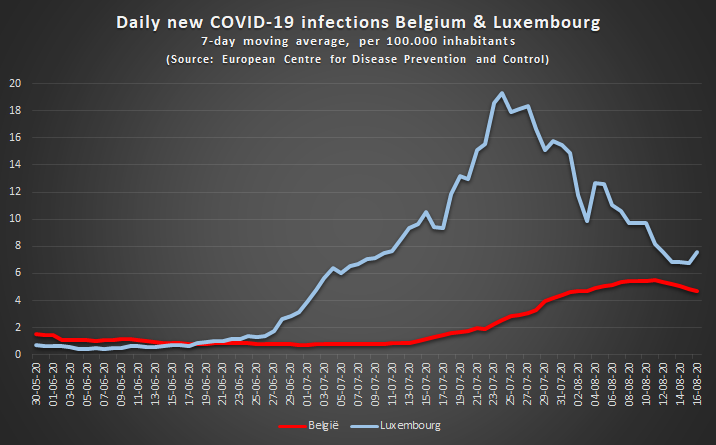Across the border
An absurd thought experiment
End of April, Luxembourg announced its ambition to test the entire population for the coronavirus. It would also provide this service to the more than 200,000 foreigners crossing the border each day to work in Luxembourg. Frontier workers from France, Germany and Belgium account for 45% of the country’s working population.
Luxembourg largely lived up to its promise. By August 16, it had carried out 736 tests per 1,000 inhabitants. It has outpaced all other countries.

Mid-June, the number of infections started to increase in the Grand Duchy. By early July, it had tripled. This triggered alarm bells throughout Europe. Belgium announced travel restrictions. It assigned to Luxembourg a “code orange”, initially for arrivals only. Given the army of 47,000 cross-border commuters from Belgium, this was understandably to the dismay of Xavier Bettel, Luxembourg’s prime minister.
On August 16, Belgium had performed 174 tests per 1,000 inhabitants, less than one quarter of its neighbor’s level. In the months of June and July, Luxembourg found 2600 new cases, Belgium 10,676. This suggests a 4,5 times higher incidence rate in Luxembourg (424 cases per 100,000 inhabitants, versus 93).
Just an absurd thought. Suppose 1926 Belgian frontier workers were newly infected in June and July. Their status went unnoticed in Belgium. Instead they ended up in the Luxembourgian statistics. If we now redo the calculations, Belgium and Luxembourg are at par: 110 cases per 100,000. At higher numbers than 1926, the June-July wave would have originated more in Belgium than in Luxembourg.
1926 on 47,000 is 4%. Perhaps not even such an absurd thought, after all.
Sources data
on COVID-19 cases and deaths per country: European Centre for Disease Prevention and Control
on COVID-19 tests per country: Our World in Data
Further reading (in Dutch):
Ricus van der Kwast, Wat we kunnen leren van de Luxemburgse coronabestrijding, Joop.nl, 26/08/20
(rvdk)



Pingback: A numbers man's nightmare - The Corona Diaries